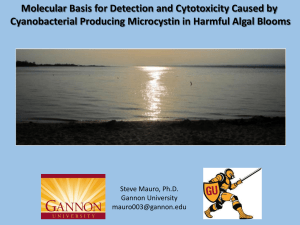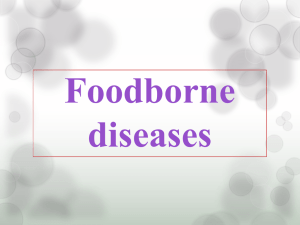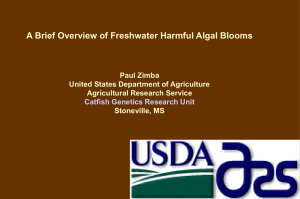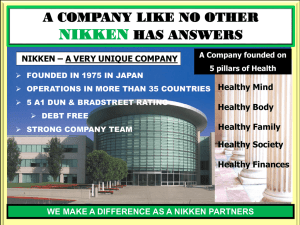Toxin Talk - Pennsylvania Sea Grant
advertisement
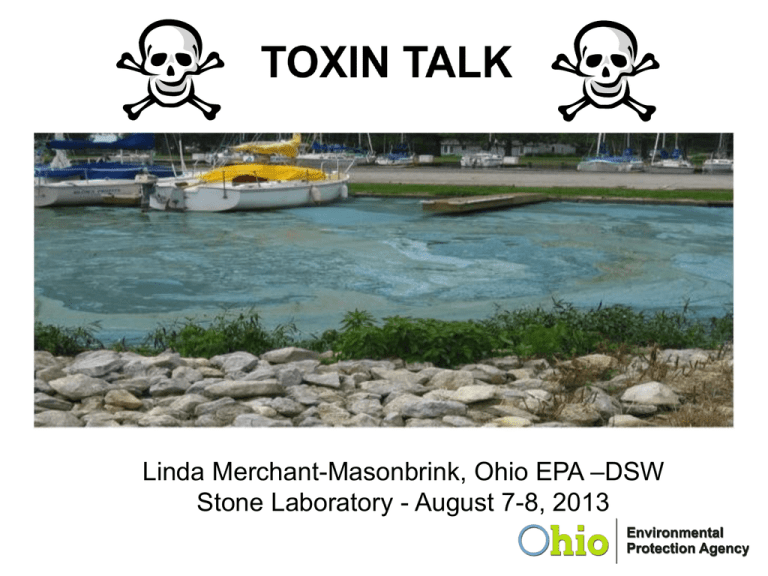
Linda Merchant-Masonbrink, Ohio EPA –DSW Stone Laboratory - August 7-8, 2013 Cyanobacteria (blue-green algae) are not true algae, but photosynthetic bacteria Cyanotoxins - Many cyanobacteria can produce liver, nerve and/or skin toxins : Acute Impacts - immediate, severe impacts from rash to death. Chronic impacts - impacts realized over time (i.e. liver tumors) Bloom occurs when there is a rapid increase or accumulation HAB is a bloom that involves toxic or otherwise harmful species of cyanobacteria or algae (marine and freshwater) Toxin production • Human and animal illness Causes taste and odor problems • Many species also produce the T&O compounds methylisoborneal (MIB) and geosmin • USGS Study: geosmin and MIB co-occurred with cyanotoxins in 91% of the blooms tested Increased organic carbon load • Concern for water treatment due to TTHMs Dissolved oxygen dips (esp. in early AM) • Can result in fish kills Creates nuisance • Visual and olfactory effects can be significant and cause economic impacts Out-competes desirable aquatic species. Some have ability to adapt to low nitrogen levels and varying light levels: -nitrogen fixation -Aphanizomenon,Nostoc -buoyancy regulation - Microcystis, Aphanizomenon , Anabaena, Planktothrix According to USEPA, HABs are increasing in spatial and temporal prevalence in the US and worldwide. “Their highly potent toxins are a significant hazard for human health and ecosystem viability.” Cyanobacteria and their toxins are on USEPA’s Office of Water Unregulated Contaminant Monitoring Regulation List 3 and Contaminant Candidate List. Scientists don’t know why toxins are produced. Theories: Primary role in cellular processes Secondary metabolites-by-products Allelopathy-chemical substance that acts as a germination or growth inhibitor on another organism Defense Mechanism Consider Genus/Species/Strain -Type of toxin is strain, NOT species dependent (genetic testing) -Co-occuring multiple strains Not related to cell density, however higher concentrations may be found in scums (in large accumulations of live cells producing toxins) Some recent USGS evidence that cyanotoxins may co-occur with taste and odor events at PWS Released during cell death. (However, neurotoxin from Aphanizomenon- released during growth) Released during application of algaecides Released in stomach Released during sonication for sample preparation of raw water. Hepatotoxins (liver toxins) •Microcystins •Cylindrospermopsin •Nodularins Neurotoxins (nerve toxins) •Anatoxin-a and Anatoxin-a(s) •Saxitoxin •Neosaxitoxin •BMAA (Beta-n-methylamino-L-alanine) Dermatotoxins (skin toxins) •Lyngbyatoxin-a •Aplysiatoxin •Lipopolysaccharides (tumor promoter) Toxin Reference Doses Dioxin (0.000001 mg/kg-d) Microcystin LR (0.000003 mg/kg-d) Saxitoxin (0.000005 mg/kg-d) PCBs (0.00002 mg/kg-d) Cylindrospermopsin (0.00003 mg/kg-d) Methylmercury (0.0001 mg/kg-d) Anatoxin-A (0.0005 mg/kg-d) DDT (0.0005 mg/kg-d) Selenium (0.005 mg/kg-d) Botulinum toxin A (0.001 mg/kg-d) Reference Dose = amount that can be ingested orally by a person, above which a toxic effect may occur, on a milligram per kilogram body weight per day basis. Alachlor (0.01 mg/kg-d) Cyanide (0.02 mg/kg-d) Atrazine (0.04 mg/kg-d) Fluoride (0.06 mg/kg-d) Chlorine (0.1 mg/kg-d) Aluminum (1 mg/kg-d) Ethylene Glycol (2 mg/kg-d) Compound LD50 (μg /kg) Compound LD50 (μg /kg) Saxitoxin 9 Ricin 0.02 Anatoxin-a(s) 20 Cobra Toxin 20 Microcystin LR 50 Curare 500 Anatoxin-a 50 Strychnine 2000 Neurotoxins - Rarely associated with human illness and death. Associated with many animal deaths, especially dog deaths Hepatotoxins – Human toxicoses from drinking water, contact during recreational activities (including inhalation), and haemodialysis Cyanobacteria Toxins Produced Type of Toxin Anatoxins, Saxotoxins Neutotoxin Microcystins Hepatoxin Anatoxins, Saxotoxins Neutotoxin Cylindrospermopsin Hepatoxin Cylindrospermopsin Hepatoxin Saxotoxins Neutotoxin Microcystis Microcystins Hepatoxin Nodularia Nodularins Hepatoxin Nostoc Microcystins Hepatoxin Anatoxins Neutotoxin Cylindrospermopsin Hepatoxin Microcystins Hepatoxin Anabaena Aphanizomenon Cylindrospermopsis Planktothrix (Oscillatoria) Most common species found in Ohio Some Symptoms: Vomiting, Diarrhea, Death (hours to few days), Liver Tumors Hepatoxins Include: Microcystins (tumor producer). Nodularins, Cylinderospermopsin (genotoxin) -Human toxicoses reported from drinking water, contact during recreational activities (including inhalation), and haemodialysis Some Species Producing Microcystins (most toxin released during cell death/lysis): ▪ Microcystis sp. ▪ Anabaena sp. ▪ Planktothrix sp. ▪ Gleotrichia sp. • Most commonly detected algal toxin is microcystin • 80 Kinds of Microcystin Toxins (congeners with range of toxicities) • Microcystin-LR is the only toxin with a risk-based provisional criteria established by the World Health Organization (WHO) 1 ppb for drinking water 20 ppb for recreational contact No WHO criteria for other toxins and No national standards for ANY toxins Woodsfield Reservoir (September 2010) 9 ppb detected at Grand Lake Beach No national standard Green Water Labs - Do not typically see at any level other than a 30 ppb level from (Delaware) a couple of years ago . LD50 is roughly 2100 µg/kg which is pretty high relative to the other cyanotoxins. Some Symptoms: Staggering, Gasping, Convulsions Diarrhea, Death (minutes to hours) Toxins include saxitoxin, neosaxitoxin, anatoxin-a, anatoxin a(s) - Rarely associated with human illness and death. Associated with many animal deaths, especially dog deaths Some Species Producing Neurotoxins: ▪ Anabaena sp.(neurotoxin released during cell death) ▪ Aphanizomenon sp. (neurotoxin released during growth) ▪ Microcystis sp. ▪ Planktothrix sp. ▪ Lyngbya sp. (Paralytic Shellfish Poisons) In some marine and freshwater algae Pufferfish poisoning results from saxitoxin Most lethal non-protein toxin (0.2 mg saxitoxin kills average size human) Selective blockage of sodium channels Stable in neutral and acid conditions and high temperatures but inactivated by strong alkalines 1,000 x more toxic than sarin (ingested or inhaled) CIA used for suicide capsules in 1950’s Francis Gary Powers (1960)-on drill bit inside a silver dollar Agent TZ-stockpiles as Schedule 1 chemical agent On the WMD list -No national standard Originally called Very Fast Death Factor (VFDF) due to rapid death in mice with I.P. injection of toxin–producing cells Responsible for many animal poisonings, including dogs and cattle. 4 ppb and 3 ppb detected at Grand Lake beaches in 2010 No national standard USGS-Kansas – Nationwide, anatoxin usually detected 30% of the time microcystin detected. -Handful of detections over 4 ppb in 500-1000 samples when looking for anatoxin-a -Highest value so far was 9.5 ppb -Most measurements 1.5 ppb or lower Green Water Labs - Florida and North Carolina detect anatoxin-a in 5% of 600+ samples. ( 3 samples at 1.0 ppb, and the rest were 0.05-0.5 ppb) -Other than 1 sample at 20 ppb, Grand Lake is the highest anatoxin seen in 1000+ samples analyzed for anatoxin a Beta-n-methylamino-L-alanine A neurototoxic non-protein amino acid Studies underway to determine if there is link to neurodegenerative diseases like Amytrophic Lateral Sclerosis (ALS) and Alzheimers disease. BMAA documented to biomagnify up the food chain in Guam: ▪ Symbiotic cyanobacteria within specialized roots of Cycads… to seeds (and flour)….. to flying foxes, pigs and deer…. to humans. Biomagnification up to 100 fold greater than free BMAA in seeds. Protein-bound BMAA found in brains of ALS patients in Guam. Some symptoms: swimmers’ itch, skin rashes, eye irritations Toxins include cytotoxins Some species producing cytotoxins: ▪ Gleotrichia sp. ▪ Lyngbya sp. •Cutaneous inflammation with signs of erythema, blisters and desquamation within 12 hrs of exposure • Severe oral and gastrointestinal inflammation • Skin tumor promoters and protein kinase C activators Rash associated with Lyngbya majuscula bloom in Australia Toxins are colorless and odorless and water soluble. Toxins disperse with wind and currents Toxin-producing cyanobacteria can occur under different environmental conditions (under ice, or hot dry summers etc.) Some cyanobacteria are not always seen at the surface yet produce toxins at depth. Blooms and toxin production are transient. May not be a problem one year but a problem the next. Cyanotoxins can persist for a long time after the bloom disappears. Not all cyanobacteria produce toxins, and those that do, don’t produce the toxin all the time or they may produce multiple toxins at the same time or sequentially. Reason for toxin production currently unknown. Not associated with cell density. Type of Organism (Genus/Species/Strain) Type of Presentation Scum (surface accumulation) Dispersed throughout water column Vertical position Consider type of organism – buoyancy? Spatial Location Consider wind direction, current, waves Consider beaches and intakes Bacterial Action Sunlight Water Treatment Plants Note: Boiling does not destroy toxin Water may be clear after a bloom event. But toxin levels may be high for some time. May take months for toxins to break down. Think twice before you lyse! •It is much easier to remove toxins when held within the algal cells •Conventional treatment less effective on extracellular toxins (Figure from Graham, Loftin, Ziegler, and Meyer, 2008) •Recreational Waters (ingestion during swimming, boating and other and physical contact) •Aerosolization (irrigation, boat spray, etc.) •Food Web (accumulation in fish…) •Dietary Supplements •Drinking Water Microcystin * Anatoxin-a Cylindrospermopsin Saxitoxin* Recreational Public Health Advisory 6 80 5 0.8 Recreational No Contact Advisory** 20 300 20 3 Drinking Water: Do Not Drink Advisory 1 20 1 0.2 Drinking Water: Do Not Use Advisory 20 300 20 3 Type of Advisory *Microcystin and Saxitoxin thresholds are intended to be applied to total concentrations of all reported congeners of those toxins. **A No Contact Advisory is issued when toxin levels exceed the recommended threshold and there are one or more probable cases of human illness or pet deaths attributable to HABs. World Health Organization – Adult threshold is 20 ppb for recreation and 1 ppb for drinking water. The State of Ohio recreational thresholds are based on a 15 kg child. Produced by Euglena spp. (unicellular, eukaryotic, flagellated protist) • Euglena sanguinea and Euglena granulata (at least) produce euglenophycin • Euglena are not bacteria like cyanobacteria • Euglena are motile unlike cyanobacteria • Bloom observed in Dillon Lake and Williams Reservoir in Lima (2012) • Known to be toxic to fish and cattle. • Toxin is a neurotoxin similar to fire ant venom. Unknown toxicity for humans. Only 2 labs that study this toxin: • NOAA • Dr. Zimba at University of Texas A&M Whenever this bloom is sighted, contact Ohio EPA to coordinate sending samples to Dr. Zimba for analysis. • Survey beach areas, especially those downwind or in coves. • When a bloom is sighted, divide the beach into three equally separated perpendicular transects from shore. • Collect three samples along each transect (ankle depth [collect 15 cm below surface at this location], knee depth and hip depth [collect 30 cm below surface at these locations]) and place in a clean bucket as samples are collected. • Thouroughly mix the composite samples and while mixing, decant a least 500 ml in a 1-quart Cubitainer or other clean, non-breakable container. • If a scum is present outside the transect lines, collect a separate sample in another container for separate toxin analysis. • Immediately place in a cooler on ice. Ship overnight to the laboratory to process. Holding time is 36 hours. If samples can’t arrive to the laboratory in that time, freeze the sample until you are ready to ship it. • Note: Sampling for saxitoxin requires a preservative. If Public Water Supply Operators are unable to sample at their intake , Ohio EPA will conduct the sampling. Heather will talk about the sampling protocol in her presentation. Many states use cell counts to infer toxin levels based on WHO benchmark criteria: 20,000 cyanobacteria cells/ml (4-10 ppb microcystins expected) 100,000 cyanobacteria cells/ml (20 ppb microcystin expected for Microcystis spp and 50-100 ppb expected if Planktothrix agardhii dominates) Many states, like Ohio, use ELISA (Enzyme-Linked Immunosorbent Assay) Total Toxins – For Recreational Waters Free Toxins- For Finished Waters Toxins: • • • • ELISA Qualitubes (for PWS) - Lab Strip Tests (recreational waters) - Field QpCR – genetic determination of potential to produce toxin - Lab Phytoplankton: • • • • FlowCam Radiometer – Hand held or buoy based Satellite with algorithms Cell counts

